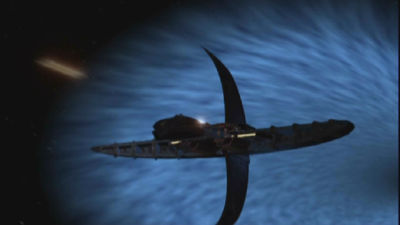Centauri
Ion Cannons

Since Babylon 5 second
season, one of the staples of Centauri weapons has been the Ion
Cannon. This weapon, featured on all Centauri warships, fires a
dense bolt of ionized particles and is a step above the plasma cannons
used by the Narn Regime and Earth Alliance. The following provides
us with examples of the Centauri Ion Cannon and how powerful this
weapon is.
|
|
In the Season Two
episode "The Fall of Night" a Centauri warship fired
on the Babylon 5 station, blowing off one of Babylon 5's forward
docking mandibles. The Centauri Primus class Battlecruiser
fired 18 bolts at the Babylon 5 station.
Some missed their
target harmlessly passing above or below the docking mandible,
but nine of the eighteen bolts did indeed strike the mandible
and succeeded in blowing it off. Dimensions of the area blown
off were averaged 40z, 54y, 114x and 39z, 57y, 112x. This
means the volume destroyed would have been 247,724.25 m^3.
With an average
density of 400 kg/m^3, the volume destroyed would have been
99,089,700 kg. Establishing the lower limit on the effectiveness
of this weapon, we must examine its effect. The bolts appeared
to both explode and burn through the mandible, some bolts
passing through the mandible and continuing on their trajectory,
vanishing off screen. This suggests that the bolts were vaporizing
the target area upon impact, not just burning, boiling or
disintegrating it. To finish establish this lower limit we
will use iron as our base material.
It takes 7,845,085.6
J/kg to vaporize iron. If vaporization did occur, at a density
of 400 kg/m^3 at a total of 99,089,700 kg, the nine Centauri
bolts would have struck with a total of 7.7*10^14 joule. Averaged
out the figure per bolt and the weapons fire form the Ion
Cannons comes to 8.6*10^13 joule.
As the bolts, even
the initial ones, actually passed through the mandible however,
and given that with each following strike there was less and
less for the new bolts to destroy, the output of the Centauri
Ion Cannon is probably an order of magnitude greater than
what is shown above. Rounding up, this gives the Centauri
Ion Cannon a low-end output of 1.0*10^14 joule (100
Terajoules), per bolt.
In the TV movie
"In the Beginning" we saw a Centauri Vorchan jump out of Hyperspace
and fire upon a Narn G'Quan class Heavy Cruiser. Said Vorchan
fired a total of six volleys, each volley consisting of two
Ion Cannon bolts. The Vorchan succeeded in destroying the
Narn vessel before the Narns even had time to react, the Centauri
attack being 1.2*10^15 joule or equivalent to a 285.7 kiloton
nuclear strike. This is, of course, assuming that the Ion
Cannon sported by the Vorchan is the same as those on the
Primus, which we know they are not. Plus, the Centauri's fire
struck the center globe on the G'Quan cruiser which is believed
to be the location of their main reactor.
|
|
Starting
from 150 Kelvin or 150 degrees above absolute zero to
the melting point of iron. 1811 K is the melting point
of iron, so 1811K - 150K = 1661 K
1661
K * 449 J/(K*kg) = 745,789 J/kg
The heat of Fusion (melting)
13,800 J/mol * 1 mol/55.847g = 247.1 J/g
247.1 J/g * 1000 g/1 kg = 247,100 J/kg
The Boiling point
3134 K is the Boiling Point of iron.
3134 K -1811 K = 1323 K = 594,027J/kg
The Heat of Boiling (Vaporization)
349,500 J/mol * 1 mol/55.847g = 6,258.1696 J/g
6,258.1696 J/g * 1000 g/1 kg = 6,258,169.6 J/kg
The
Total Energy required to Vaporize 1 kg of iron, equals
"7,845,085.6 J/kg"
|
|
CONCLUSION - The total
low-end output of what we assume to be a standard
discharge from a Centauri Ion Cannon, comes to 1.0*1014
watts (100,000,000,000,000
watts - 100 Terawatts),
or equal to a 23.8 kiloton bomb.
As we know
that B5 armor is NOT comprised of iron, and the general consensus
is that the armor is at least 20X stronger than our base matterial,
the Centauri Ion Cannon must have an average output
of at least 2.0*1015 watt (2,000,000,000,000,000
watt - 2,000 Terawatt),
or equal to an 476.2 kiloton bomb.
|
![]()